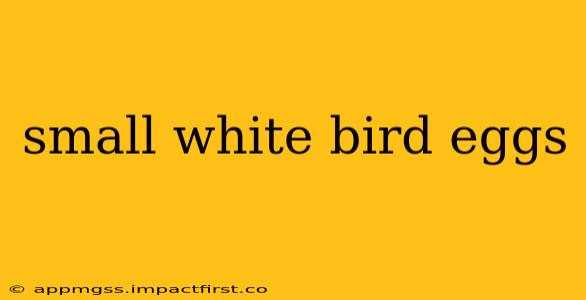Many bird species lay small, white eggs, making identification challenging. This guide dives deep into the characteristics of these eggs, exploring the various bird species that lay them, their nesting habits, and how to differentiate between them. Understanding these nuances will help bird enthusiasts, nature lovers, and researchers alike.
What Birds Lay Small White Eggs?
This is a frequently asked question, and the answer depends on several factors, including location and habitat. Many small passerines (perching birds) lay small white eggs. However, some species lay eggs that are slightly off-white or have faint markings. Some examples include:
- House Wrens: These tiny birds lay speckled white eggs, usually 6-8 in a clutch.
- White-crowned Sparrows: Their eggs are typically white with brown spots.
- American Robins: While known for their blue-green eggs, some variations can appear almost white, especially if they are heavily blotched with darker colors.
- Barn Swallows: Laying pure white eggs in a cup-shaped nest, they are often observed in barns and other human-built structures.
- Several species of Flycatchers: Depending on the species, flycatcher eggs can range from pure white to speckled white.
It's crucial to remember that egg color is not a definitive identification factor on its own. Size, shape, markings, nest location, and the bird's behavior all contribute to accurate identification.
How Can I Identify Small White Bird Eggs?
Identifying small white bird eggs requires careful observation and consideration of multiple clues. Here's a breakdown of key factors:
- Egg Size and Shape: Measure the egg's dimensions and note its shape (oval, pointed, etc.). This provides crucial clues to the bird species. A small, almost perfectly round egg might indicate a different species than a slightly elongated one.
- Markings: Even if predominantly white, some eggs might have faint speckles or spots. The color, density, and pattern of these markings are essential for identification.
- Nest Location and Structure: The location and structure of the nest offer vital clues. A nest in a tree cavity might indicate a different bird than a nest placed on the ground or in a shrub.
- Clutch Size: The number of eggs in a clutch (a group of eggs laid at one time) is another important indicator. Some species lay many eggs, while others lay only a few.
- Bird Behavior: Observing the adult birds feeding the young or building the nest offers vital information for identification.
What are the Sizes of Small White Bird Eggs?
The size of small white bird eggs varies significantly depending on the species. It’s essential to understand that "small" is relative. There isn't a single definitive size for a small white bird egg. A measurement comparison between different species is necessary to accurately determine the size of an egg. You should refer to a field guide specific to your region for accurate measurements.
Are There Any Differences in the Shells of Small White Bird Eggs?
While the color might be similar, subtle differences exist in the shell texture and porosity. Some eggshells might be smoother than others, and the porosity (how easily air can pass through) can vary. These characteristics are often subtle and require close examination under magnification. Again, a field guide is an invaluable resource for identifying these distinctions.
Where Can I Find More Information on Bird Eggs?
Numerous resources exist for learning more about bird eggs. Field guides specific to your region are excellent starting points, providing detailed descriptions and illustrations of various bird species and their eggs. Online databases and bird identification websites often include egg photos and descriptions. Local ornithological societies and nature centers also provide valuable information and resources. Remember to always observe birds and their nests ethically and from a distance, respecting their natural environment.
This comprehensive guide provides a starting point for understanding the fascinating world of small white bird eggs. Remember that accurate identification often requires careful observation, patience, and access to reliable resources. Happy birding!
